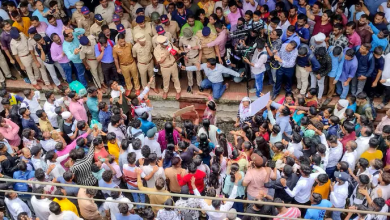Legal Complexities: Watch GN Saibaba’s Acquittal Journey

In a significant turn of events, Delhi University professor GN Saibaba, once entangled in the web of Maoist links, emerged from Nagpur Central Jail on Thursday as a free man. Alongside him, five others were recently acquitted by the Nagpur bench of the Bombay High Court, marking the culmination of a legal saga that began with Saibaba’s arrest in 2014.
The Acquittal Verdict
The Nagpur bench of the High Court, comprising Justices Vinay Joshi and Valmiki SA Menezes, overturned a 2017 conviction by a sessions court that had sentenced Saibaba and his co-accused to life imprisonment under the Unlawful Activities (Prevention) Act (UAPA). This landmark decision came after the appeal was reheard by the Supreme Court, which had initially reversed the High Court’s earlier acquittal verdict, as reported by ANI.
Supreme Court’s Intervention
On April 19, 2023, the Supreme Court overturned the High Court’s judgment to discharge Saibaba and others. This came in response to a petition from the Maharashtra government challenging the verdict. Subsequently, the Supreme Court postponed the High Court’s decision to release the defendants on October 14, 2022. Despite being granted the right to request bail, the accused, including Saibaba, awaited the Supreme Court’s ruling while languishing in jail.
Allegations and Acquittal
Initially convicted by the Sessions Court in Gadchiroli, Maharashtra, the accused were charged with being members of the Revolutionary Democratic Front (RDF), reportedly linked to an illegal Maoist organization. However, the recent acquittal by the High Court has effectively overturned their prior convictions.
Co-Accused and Tragedy
Besides Saibaba, the High Court acquitted Mahesh Kariman Tirki, Pandu Pora Narote, Hem Keshavdatta Mishra, and Prashant Rahi, all of whom faced life sentences. Additionally, Vijay Tirki, sentenced to ten years, and unfortunately, the late Pandu Pora Narote, who passed away during the appeals process, were also part of this legal odyssey.
In navigating the complexities of legal battles, the saga of GN Saibaba’s acquittal stands as a testament to the resilience of justice. This journey, marked by twists and turns, underscores the importance of a thorough and impartial legal process.
FAQs
- Why was GN Saibaba arrested in 2014?
- Saibaba was arrested on allegations of Maoist links, specifically being accused of being a part of the Revolutionary Democratic Front (RDF).
- What led to the High Court’s acquittal decision?
- The Nagpur bench of the Bombay High Court acquitted Saibaba and others, overturning a 2017 conviction, after a thorough reconsideration of the case.
- How did the Supreme Court intervene in the acquittal process?
- The Supreme Court initially reversed the High Court’s acquittal, responding to a petition from the Maharashtra government, but later upheld the acquittal in 2023.
- Were there any casualties during the legal proceedings?
- Unfortunately, Pandu Pora Narote passed away during the appeals process, adding a tragic dimension to the unfolding events.
- What charges were the accused facing?
- The accused, initially convicted by the Sessions Court, were charged under the Unlawful Activities (Prevention) Act (UAPA) for their alleged involvement with the Revolutionary Democratic Front (RDF).









